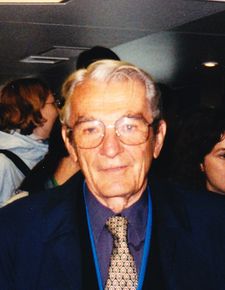Ivar Giaever
| Ivar Giaever | |
|---|---|
 |
|
| Born | April 5, 1929 (age 81) Bergen, Norway |
| Nationality | Norway, USA (1964) |
| Fields | physics |
| Known for | solid-state physics |
| Notable awards | Nobel Prize in Physics (1973) |
Ivar Giaever (originally spelled Giæver) (born April 5, 1929 in Bergen, Norway) is a physicist who shared the Nobel Prize in Physics in 1973 with Leo Esaki and Brian Josephson "for their discoveries regarding tunnelling phenomena in solids".[1] Giaever's share of the prize was specifically for his "experimental discoveries regarding tunnelling phenomena in... superconductors".[2] Giaever is an institute professor emeritus at the Rensselaer Polytechnic Institute, a professor-at-large at the University of Oslo, and the president of Applied Biophysics.[3]
Giaever earned a degree in mechanical engineering from the Norwegian Institute of Technology in 1952. In 1954 he emigrated from Norway to Canada, where he was employed by the Canadian division of General Electric. He moved to the United States two years later, joining General Electric's Research and Development Center at Schenectady, New York in 1958. He has lived in Niskayuna, New York since then, taking up US citizenship in 1964. While working for General Electric, Giaever earned a Ph.D. from the Rensselaer Polytechnic Institute in 1964.[4]
The work which led to Giaever's Nobel Prize was performed at General Electric in 1960. Following on from Esaki's discovery of electron tunnelling in semiconductors in 1958, Giaever showed that tunnelling also took place in superconductors, demonstrating tunnelling through a very thin layer of oxide surrounded on both sides by metal in a superconducting or normal state.[5] Giaever's experiments demonstrated the existence of an energy gap in superconductors, one of the most important predictions of the BCS theory of superconductivity that had been developed in 1957.[6] Giaever's experimental demonstration of tunnelling in superconductors stimulated the theoretical physicist Brian Josephson to work on the phenomenon, leading to his prediction of the Josephson effect in 1962. Esaki and Giaever shared half of the 1973 Nobel Prize, and Josephson received the other half.[1]
Giaever's research later in his career was mainly in the field of biophysics. In 1969, he researched biophysics for a year at Cambridge University, England through a Guggenheim Fellowship, and he continued to work in this area after he returned to the US.[4]
In addition to the Nobel Prize, he has also been awarded the Oliver E. Buckley Prize by the American Physical Society in 1965, and the Zworykin Award by the National Academy of Engineering in 1974.[3]
References
- ↑ 1.0 1.1 Nobel prize press release
- ↑ Nobel citation
- ↑ 3.0 3.1 Ivar Giaever's home page at Rensselaer Polytechnic Institute
- ↑ 4.0 4.1 Biography on the Nobel Foundation website
- ↑ doi:10.1103/PhysRevLett.5.147
This citation will be automatically completed in the next few minutes. You can jump the queue or expand by hand - ↑ Bardeen, Cooper and Schrieffer won the Nobel Prize in 1972.
External links
- Interview with Professor Ivar Giaever
- University of Oslo website about Ivar Giaever
- Applied Biophysics Website
|
||||||||||||||||||||